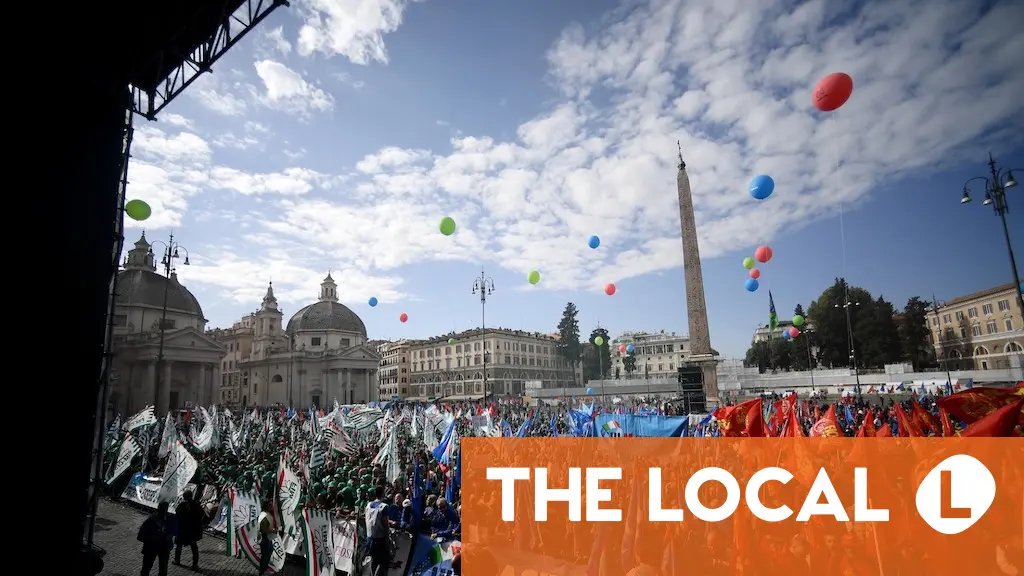Labour Day is one of the most important holidays in Italy’s spring calendar, mixing ancient traditions with modern celebrations.
A public holiday
Labour Day has been recognised as a public holiday in Italy since shortly after the fall of Fascism in the mid-1940s – more on that below.
The fact that Labour Day falls on a Thursday this year means many Italians will take the opportunity to fare il ponte and give themselves a long weekend break by taking the Friday off as well.
Parades and protests
For many in Italy, Labour Day isn’t just a day off work but also a day of action, with unions and other organisations organising rallies and marches to campaign for workers’ rights and other social issues.
Most Italian towns and cities hold some kind of march or parade, with trade unions CGIL, CISL and UIL focusing on worker safety and job security this year.
USI-CIT has called an all-day strike that may effect the healthcare and education sectors – though since May 1st is a public holiday anyway in Italy, it’s unlikely to cause much additional disruption.
READ ALSO: KEY DATES: The transport strikes to expect in Italy in May 2025
A tradition borrowed from the US
Though May 1st is Italy’s Labour Day (as it is for a long list of other countries, including France, Spain and Germany), this day of action actually has its origins in a huge strike in Chicago in 1886.
On May 1st, 35,000 workers walked out of their jobs, joined by tens of thousands more in the next couple days, leading a national movement for an eight-hour work day.
The idea of introducing an international workers’ day made its way to Europe, and Labour Day was first celebrated in Italy in 1891 – but the holiday was suppressed under Fascism, and only became an official public holiday again in 1946.
Advertisement
Music concerts
Some Italian cities celebrate May 1st with live open-air music concerts.
The biggest of these is the Concertone or ‘big concert’ held every May 1st in Rome’s Piazza San Giovanni in Luterano (though last year it briefly relocated to the Circo Massimo venue).
The event – the largest free live music concert in Europe – features performances from some of Italy’s most popular singers. This year’s lineup is set to feature Achille Lauro, Elodie, Ghali and Giorgia, among some 50 performers.
The city of Taranto, in the southern Italian region of Puglia, hosts the free concert Uno Maggio Taranto, featuring musical acts interspersed with speeches from guests and activists.
READ ALSO: Labour Day: What’s open and what’s closed in Italy on May 1st 2025
Gita fuori porta
When the weather is sunny, public holidays in Italy are often observed with a gita fuori porta, or ‘trip outside the city gates’, and Labour Day is no exception.
Italians living in towns and cities take advantage of the day off to take a day trip somewhere in nature, be that the seaside, countryside or the mountains.
Advertisement
It might involve a stroll or even a short hike, but food is always key, whether it’s lunch at a trattoria or a barbecue at a picnic spot.
Classic dishes
As is always the case on Italian holidays, food comes front and centre, and different parts of the country have their own favourite May Day dishes.
In Rome and the surrounding region of Lazio, green fava beans are eaten raw, straight from the pod, along with pecorino cheese and usually some locally produced vino sfuso (cask wine) – a tradition that dates back to ancient Roman times.
In the mountainous central Italian region of Abruzzo, virtù teramane, a thick stew made using leftover legumes, pasta and fresh vegetables is widely consumed.
And on the island of Sardinia, pilgrims make their way to the shrine of San Francesco di Lula, in the Nuoro province, where they’re served su filindeu or ‘God’s threads’ soup – a kind of minestrone made with very fine strands of pasta in a mutton broth.
Advertisement
Calendimaggio and the ‘Songs of May’
Italy’s May folk traditions and spring rites celebrating renewal and rebirth, known as Calendimaggio, date back to the ancient pagan festival of Floralia, in honour of Flora – the Roman goddess of flowers and fertility.
In the Middle Ages, young men would go into the woods on the night of April 30th and pick flowering branches to place outside the doors of young girls as a courtship ritual. Towns and villages would celebrate with music, parades, games and banquets.
Maggianti or maggerini singers would go door to door playing instruments and singing folk songs about spring, receiving meats, sweets and wine in return.
Today, towns in parts of central and northern Italy – in particular, mountain villages around the Tuscan city of Pistoia – continue the tradition of Cantamaggio folk singing.
Terni, in the central region of Umbria, stages a Carnival-style float parade on the evening of April 30th, while Assisi, also in Umbria, puts on a whole month of Calendimaggio celebrations.

